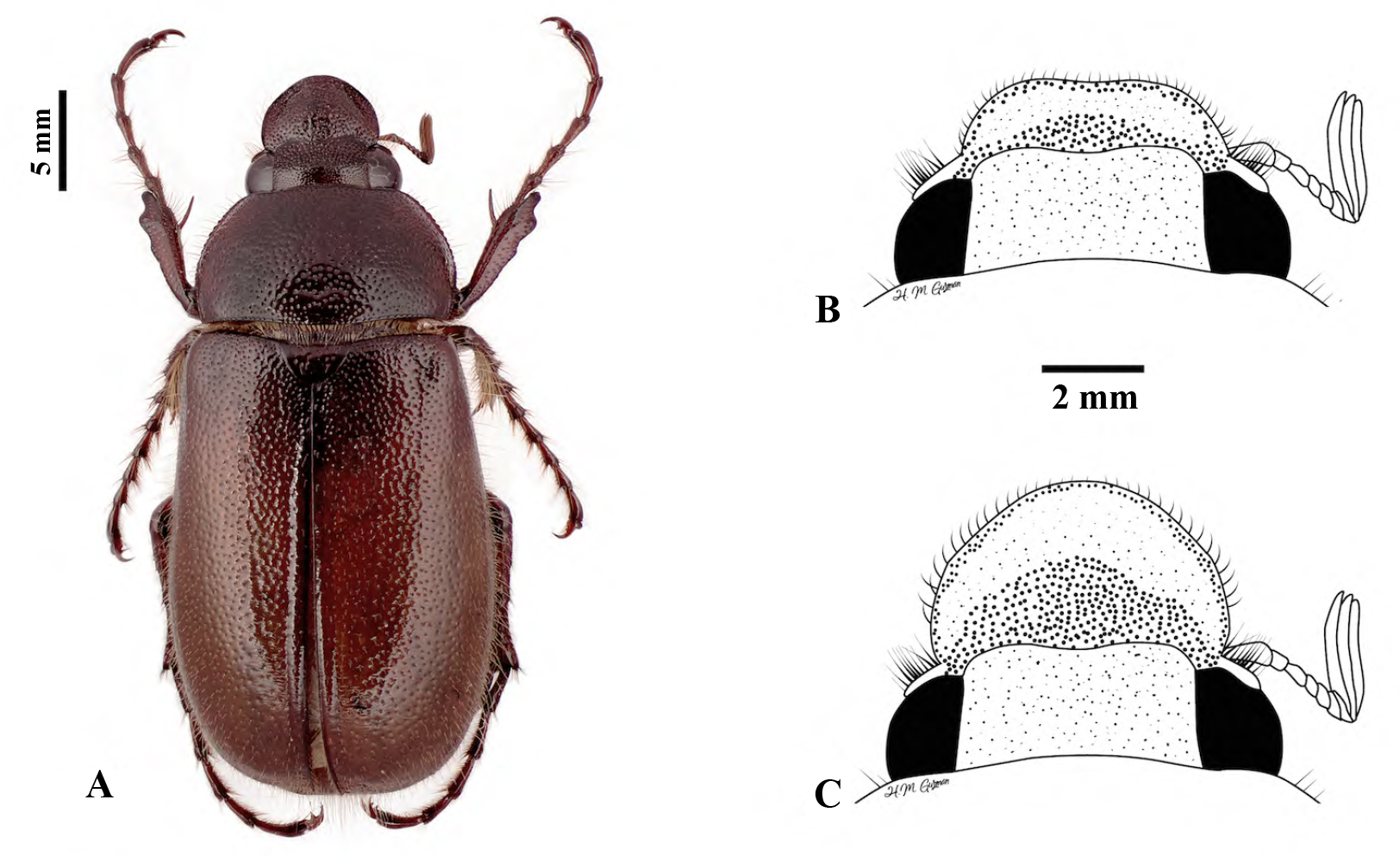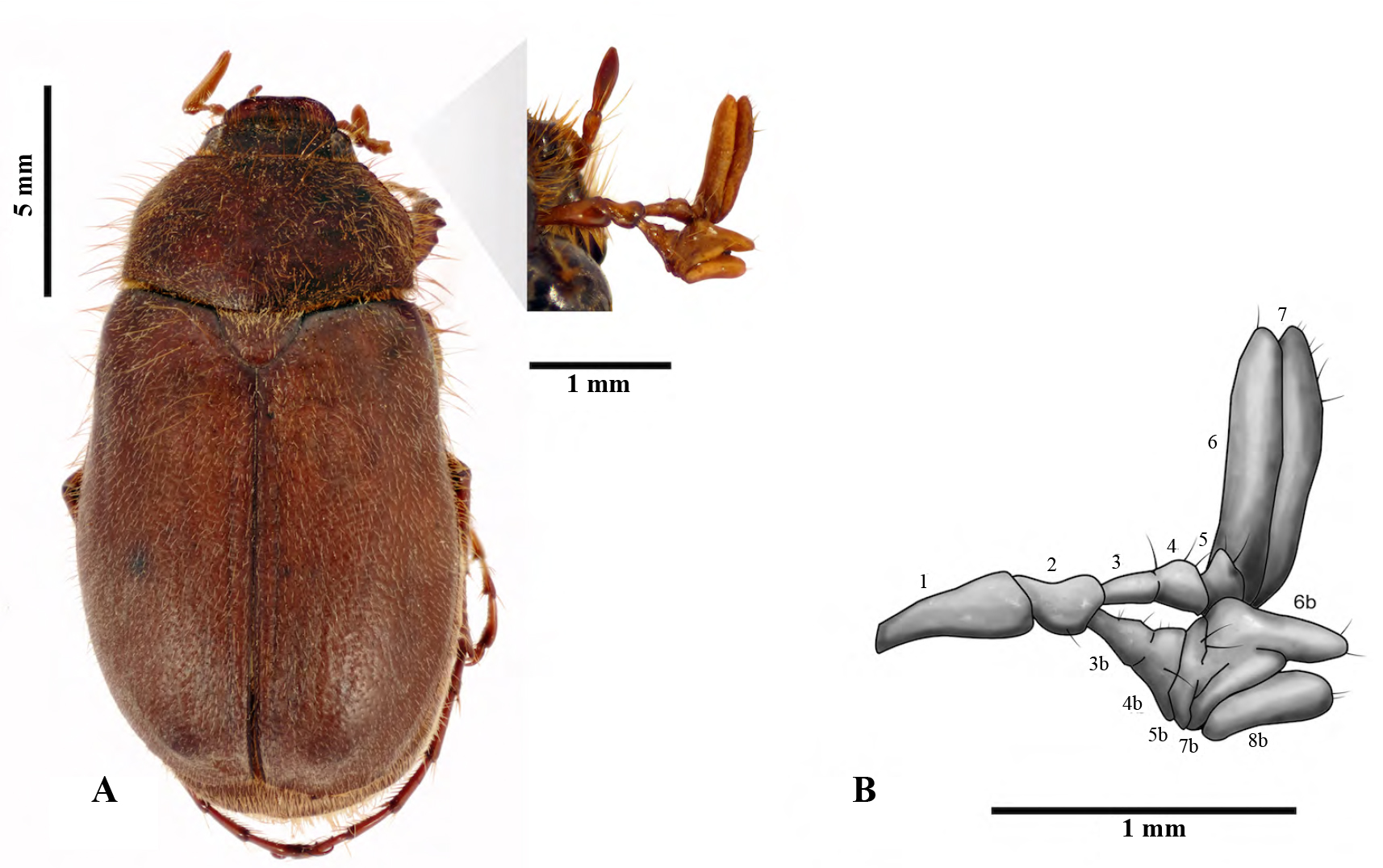Introduction
Teratology is defined as the study of structural anomalies, monstrosities and malformations (Torre-Bueno 1985). Teratologies in insects are usually not reported, since they are not considered to have a taxonomic value because they are specimens that present atypical morphological characters to the taxon to which they belong (Caruso and Savini 2012). However, it is very important that entomologists and especially taxonomists consider teratological cases, as they can offer valuable information on the influence of endogenous and exogenous factors in the process of embryonic development (Savini and Furth 2004; Caruso and Savini 2012). Teratologies can be grouped into four major categories: general, corporal, appendicular and wing-elytra anomalies. These can be divided into several groups according to their typology (Balazuc 1948; Ortuño 2000). The majority of anomalies described in insects are related to the development and structure of the appendages, the most common of being symphysoceries (fusion of segments), schistomelies (branch of appendages) and dystrophies (reduction of the appendix size) (Cockayne 1937; Ortuño and Peláez 2004).
Of the reports on teratomorphous insects, the order Coleoptera has the highest number of described cases (Savini and Furth 2004; Márquez and Sierra-Martínez 2008). The most frequent families are Carabidae, Cerambycidae, Staphylinidae, Chrysomelidae (Savini and Furth 2004; Ortuño and Ramos-Abuín 2008), and recently Scarabaeidae (Gasca-Álvarez et al. 2017), Lucanidae and Geotrupidae (Kizub and Leshchenko 2019). Regarding the genus Phyllophaga Harris, 1827, only malformations of the antenna and legs have been described in P. (Cnemarachis) bruneri Chapin, 1932 and P. (Phyllophaga) glaberrima (Blanchard, 1851), respectively (Dodge 1965; Ferreira 2011).
New cases of malformations in two species of Phyllophaga are described here. This work continues the study of teratologies in the superfamily Scarabaeoidea (see Gasca-Álvarez et al. 2017 and Gasca-Álvarez et al. 2018).
Materials and methods
A total of 830 specimens of the genus Phyllophaga were reviewed; these specimens were collected under street lighting in two collection events: the first event was held in 2013 in the locality of Santa Cruz Itundujia, and the second event in 2017 in the locality of Santa Ana Tututepec. Both in Sierra Sur region of the state of Oaxaca, Mexico. Additional information of the localities is included in the labels of the analyzed specimens.
For the taxonomic determination of the specimens, the key of Morón (1986) was used, the original descriptions of Bates (1888) were reviewed and the male genitalia were compared with the photographs and illustrations presented in Morón (1986), Cano and Morón (1999), and Hernández-Cruz et al. (2014). Also, the determination was corroborated by Dr. Miguel Ángel Morón (R.I.P.) in the Institute of Ecology (INECOL Xalapa, Veracruz). For the identification of the type of anomalies, as well as the terminology and classification we follow the proposed of Balazuc (1948), Ortuño and Hernández (1993), Ortuño and Vique (2007), Asiain and Márquez (2009) and Ceccolini and Paggetti (2015). Images were taken with a Canon EOS Rebel T6 camera adapted to a stereo-microscope Zeiss model Stemi 508. The examined specimens are deposited in the insect collection of the Centro Interdisciplinario de Investigación para el Desarrollo Integral Regional (CIIDIR), Unidad Oaxaca, Instituto Politécnico Nacional (IPN).
Results
Of the 830 specimens examined, 300 individuals belong to P. dasypoda and 530 to P. misteca. Only one specimen of each species showed abnormalities. The two teratological cases are described below:
Case 1
Material examined. Phyllophaga (Phyllophaga) dasypoda (Bates, 1888) (Fig. 1A). 1(♂. México, Oaxaca, Juquila, Santa Ana Tututepec. 16º10’53ˮN 97º31’50ˮO, 445 m. Manual capture, 2-June-2017. Cruz Ruíz, E. [IPN-CICO]
Type of anomaly. Clypeal hypertrophy.
Description. The head presents a malformed clypeus due to the presence of a prominent projection. Unlike a normal clypeus (Fig. 1B), this has a globose and parabolic aspect, exaggeratedly inflated dorsally, with greater elevation in the center and decreasing towards the edges, which are flattened (Fig. 1C).
Case 2
Material examined. Phyllophaga (Phyllophaga) misteca (Bates, 1888) (Fig. 2A). 1(♂. México, Oaxaca, Santa Cruz Itundujia, Unión de Galeana. 16º52’27ˮN 97º39’41ˮO, 2.350 m. Manual capture, 27-May-2013. Girón Pablo, H. [IPN-CICO]
Type of anomaly. Antenna with unilateral heterodynamic binary schistomely and symphysocery type 3-4, 3b-4b and 5b-6b-7b.
Description. Bifurcated right antenna. It is clearly observed that from the third antennomere it branches into two antennae (Fig. 2B). The antennomeres 3, 4, 5, 6 and 7 form the main antenna, in which the antennal club is constituted by only two antennomeres (6 and 7). Antennomeres 3 and 4 are fused. The second antenna is formed by the antennomeres 3b, 4b, 5b, 6b, 7b and 8b. The antennomeres 6b, 7b and 8b constitute the secondary antennal club. All the antennomeres of this branch are partially or totally fused except for 8b.
Discussion
The anomalies in beetles’ antennae are very frequent. Generally, the flagellum undergoes a multisegmentation process during the pupation, which unleashes errors in the arthrogenesis process in the imago antenna (Ortuño and Vique 2007). As a result, schistomelies (division of the antenna into two or more branches) and symphysoceries (partial or total antennomeres fusion) occur. These malformations have been widely studied in several Coleoptera groups (Dodge 1965; Baraud 1977; Savini and Furth 2004; Márquez and Sierra-Martínez 2008; Ortuño and Ramos-Abuín 2008; Ferreira 2011; Gasca-Álvarez et al. 2017).
The fusion of antennomeres usually produces an aberrant and dystrophic antennal piece. Antennomeres that have not been affected, occasionally are also dystrophic (Ortuño and Marcos 2003; Ortuño and Peláez 2004). The most frequent fusions occur from the 5th antennomere, with mergers that involve the 4th and 5th and very rare fusions that affect the 3rd and 4th (Balazuc 1948), as in the case of Phyllophaga misteca.
The schistomelies can be partial or total divisions of the antenna in two or more growth axes. It is possible to find schistomelies of second and third degree, multiple and even combined schistomelies (Balazuc 1948). Due to its complexity, associated symphysoceries are usually presented, such as the case described in this paper.
According to Balazuc (1948), two theories could explain the origin of the schistomelies. The division of muscle fibers and the production of an exaggerated plastic force that generates inequality in the distribution of fibers, cause an excess at the apex of the appendages and leads to division. The second theory is related to the multiple formation of imaginal discs during the last larval stage, which would give rise to partial organs. However, the genetic basis of this type of malformation is still unknown.
The case of the clypeus with excessive growth and development, is a very rare anomaly, and so far, there are no reports of this type of malformations in Scarabaeidae or in some other Coleoptera group in the literature. So, this could be the first documented case of this type of anomaly. The only close case is the unilateral deformation of the clypeus in Lucanus cervus (Linnaeus, 1758) reported by Frivaldszky (1889).
Perhaps the origin of this anomaly is due to the contact with chemical substances (exogenous factors) that were in the environment during the embryonic development (Balazuc 1948; Ghannem et al. 2015). This could possibly be due to the use of agrochemicals in crops and other types of agroecosystems (Ortuño 2000). Although it is very important to take into consideration the etiology, sometimes it is not possible to determine the exact causes that originated these malformations (Ghannem et al. 2015; Kizub and Leshchenko 2019).
Conclusions
So far, only two cases of teratology have been reported in species of the genus Phyllophaga (P. bruneri and P. glaberrima), the cases described here represent two new cases of teratologies in two species more than the previous ones. Dr. Morón (pers. comm.) frequently observed malformations in the antennae of P. (Phytalus) pentaphylla (Bates, 1888). However, we do not know the frequency of these anomalies because he did not publish this data.
It is important to document teratological cases, since they can show how the exogenous and endogenous factors influence in the processes of embryonic development. In addition, it is necessary to continue studying teratologies in order to know their origin, record the frequency with which they occur, and discover how these anomalies affect the activity of teratomorphic individuals.

















